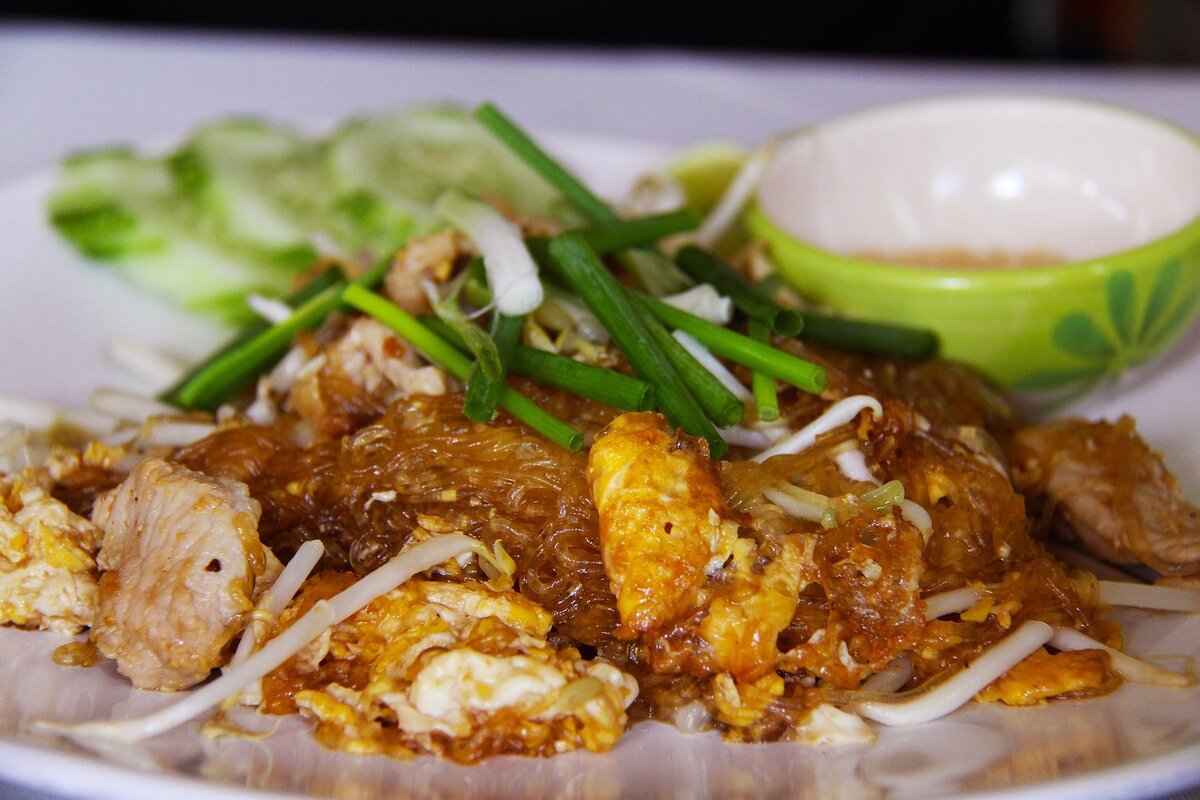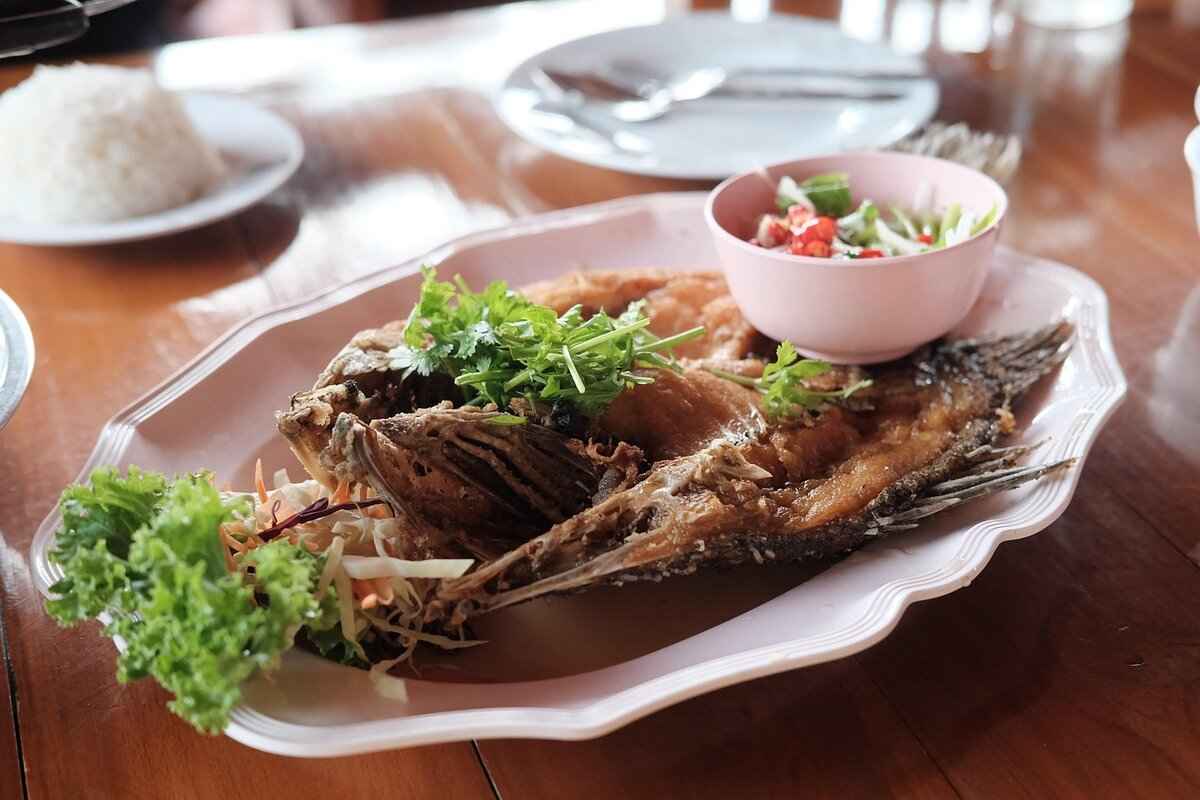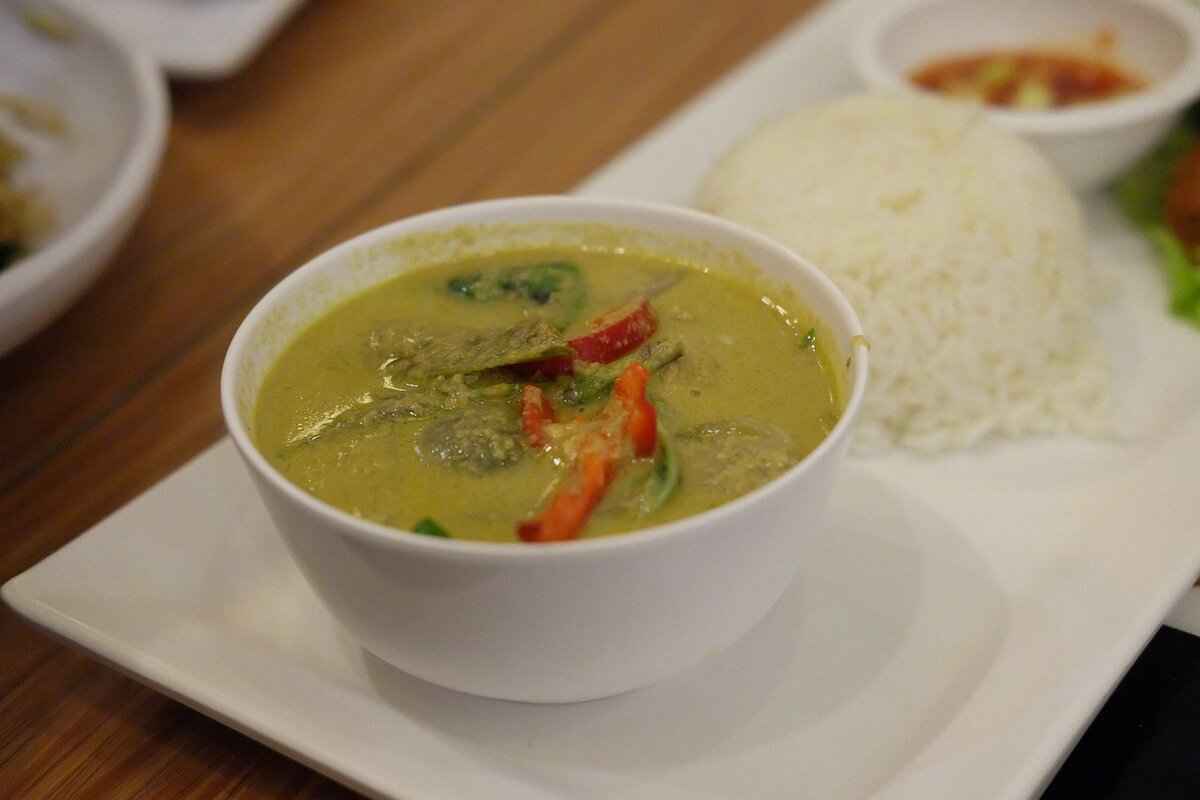Northern Thai Cuisine is a treasure trove of flavors and traditions, offering an enticing glimpse into the culinary heritage of Thailand’s mountainous region. This cuisine is renowned for its unique dishes, notably Khao Soi and Sai Ua, which are celebrated for their vibrant flavors and aromatic spices. As you delve into Northern Thai food, you’ll discover the cultural significance and the stories behind these beloved dishes.
Khao Soi is a signature dish of Northern Thailand, characterized by its rich coconut curry broth and tender egg noodles. This dish beautifully marries the flavors of spices with creamy coconut milk, resulting in a delightful and comforting meal. Traditionally, Khao Soi is garnished with crispy fried noodles, pickled mustard greens, lime, and shallots, adding layers of texture and taste.
To recreate this iconic dish at home, you will need a few essential ingredients:
- Egg noodles
- Coconut milk
- Curry paste
- Garnishes such as pickled mustard greens and shallots
Understanding these components is crucial for achieving an authentic flavor profile. A simple recipe involves boiling the noodles until tender, preparing the curry broth with the right blend of spices, and finally assembling the dish with fresh garnishes.
Sai Ua, or Northern Thai sausage, is another must-try delicacy that showcases the region’s culinary prowess. This sausage is infused with a fragrant mix of herbs and spices, including minced pork, lemongrass, and kaffir lime leaves. Often grilled to perfection, Sai Ua is typically served with fresh vegetables and a spicy dipping sauce, making it a delightful appetizer or side dish.
The secret to Sai Ua lies in its key ingredients. The combination of minced pork, chili paste, and fresh herbs creates a flavor explosion that is both aromatic and satisfying. The use of local ingredients enhances the authenticity of this dish, making it a favorite among both locals and visitors.
Sai Ua can be prepared using various methods such as grilling, steaming, or pan-frying. Each technique brings out different textures and flavors, allowing for a versatile dining experience. Grilling is particularly popular, as it imparts a smoky flavor that complements the spices beautifully.
Northern Thai cuisine stands out due to its emphasis on fresh herbs, spices, and local produce. The use of ingredients like turmeric, coriander, and chili contributes to the bold flavors that define this culinary style. Additionally, the region’s cooking techniques, such as slow cooking and grilling, enhance the depth of flavor in each dish.
In addition to Khao Soi and Sai Ua, Northern Thai meals often feature side dishes like Nam Prik Ong (a spicy tomato dip) and sticky rice. These accompaniments perfectly balance the rich flavors of the main courses, providing a well-rounded dining experience.
To truly appreciate Northern Thai cuisine, a visit to local markets and street vendors is essential. These venues offer authentic dishes prepared using traditional methods and fresh ingredients. Engaging with local chefs and vendors can also provide valuable insights into the cultural significance of the dishes.
Festivals in Northern Thailand often highlight special dishes and culinary traditions, showcasing the region’s rich food culture. Events such as the Yi Peng Lantern Festival and Loi Krathong feature unique culinary offerings that reflect the community’s spirit and heritage. Participating in these festivals is a wonderful way to explore the local flavors and connect with the culture.

What is Khao Soi?
Khao Soi is not just a meal; it is a culinary experience that encapsulates the essence of Northern Thailand. This iconic dish is a harmonious blend of flavors, textures, and colors that truly reflects the rich cultural heritage of the region. The creamy coconut curry broth, paired with soft egg noodles, creates a comforting and satisfying dish that has gained popularity both locally and internationally.
At its core, Khao Soi features a unique combination of ingredients that come together to create a delightful flavor profile. The base is a rich and aromatic coconut curry broth, which is often infused with a variety of spices, including coriander, cumin, and turmeric. This blend not only enhances the taste but also provides a beautiful golden hue to the dish.
One of the standout elements of Khao Soi is the use of egg noodles. These noodles are typically boiled until tender and then layered with the curry broth. To elevate the dish further, crispy fried noodles are often added on top, providing a delightful crunch that contrasts beautifully with the creamy broth. The dish is usually garnished with fresh herbs, lime wedges, and sometimes pickled mustard greens, adding layers of flavor and freshness.
To truly appreciate Khao Soi, it is essential to understand the significance of its ingredients. The coconut milk not only adds creaminess but also balances the spices, creating a well-rounded taste. The choice of protein, which can range from chicken to beef or even tofu for a vegetarian option, allows for personalization and caters to various dietary preferences.
When it comes to preparing Khao Soi at home, the process may seem daunting, but it can be quite straightforward with the right ingredients. Start by gathering egg noodles, coconut milk, and a good quality curry paste. The latter is critical; a Northern Thai curry paste will typically contain a mix of spices that are essential for achieving an authentic flavor.
When cooking the dish, it is important to pay attention to the cooking techniques. The egg noodles should be cooked until just tender, then fried lightly to achieve that crispy texture. The broth should be simmered to allow the flavors to meld beautifully, resulting in a dish that is both aromatic and flavorful.
Serving Khao Soi is an art in itself. It is best enjoyed hot, garnished with fresh herbs like cilantro and green onions, along with lime wedges for a zesty kick. The addition of crispy fried noodles on top not only enhances the visual appeal but also contributes to the overall texture of the dish, making each bite a delightful experience.
In summary, Khao Soi is a culinary gem of Northern Thailand that offers a rich tapestry of flavors and textures. Its creamy coconut curry broth, combined with egg noodles and a variety of toppings, makes it a beloved dish among locals and visitors alike. Whether you are enjoying it at a street vendor or recreating it at home, Khao Soi is sure to impress with its unique and satisfying taste.

How to Prepare Khao Soi at Home?
Khao Soi is a beloved dish from Northern Thailand, celebrated for its rich and creamy coconut curry broth paired with tender egg noodles. If you’re eager to recreate this culinary masterpiece in the comfort of your own home, you’re in for a treat! Below is a detailed guide on how to prepare Khao Soi, ensuring you capture the authentic flavors that make this dish so special.
Preparing Khao Soi at home involves several key steps, starting with gathering the essential ingredients. Here’s a breakdown of what you’ll need:
| Ingredient | Quantity |
|---|---|
| Egg Noodles | 200g |
| Coconut Milk | 400ml |
| Curry Paste | 2 tablespoons |
| Chicken (or tofu for a vegetarian option) | 300g |
| Pickled Mustard Greens | For garnish |
| Shallots | For garnish |
| Fresh Lime | For garnish |
| Crispy Fried Noodles | For topping |
- Prep the Noodles: Start by boiling the egg noodles in salted water until they are just tender. Drain and set aside.
- Cook the Chicken: In a large pot, add a splash of oil and sauté your choice of protein until browned. This step adds depth of flavor.
- Add the Curry Paste: Stir in the curry paste and cook for a few minutes to release its aromas.
- Incorporate Coconut Milk: Pour in the coconut milk and bring the mixture to a gentle simmer. Allow it to cook for about 10 minutes, letting the flavors meld together.
- Combine Noodles and Broth: Add the cooked noodles to the pot and stir gently to coat them in the rich broth.
The final touch to your Khao Soi is the garnishing, which elevates the dish’s presentation and flavor:
- Pickled Mustard Greens: These add a tangy crunch that balances the creaminess of the broth.
- Shallots: Sliced shallots provide a mild onion flavor and a bit of sweetness.
- Fresh Lime: A squeeze of lime juice brightens the dish and enhances the overall taste.
- Crispy Fried Noodles: These are essential for adding a delightful crunch on top of the creamy soup.
Here are some additional tips to ensure your Khao Soi turns out perfectly:
- Choose Quality Ingredients: Fresh coconut milk and authentic curry paste are crucial for achieving the right flavor.
- Adjust Spiciness: Depending on your preference, you can adjust the amount of curry paste used to make the dish milder or spicier.
- Experiment with Proteins: While chicken is traditional, feel free to use beef, pork, or even tofu for a vegetarian option.
By following these steps and tips, you’ll be well on your way to enjoying a delicious bowl of homemade Khao Soi. This dish not only warms the heart but also brings a taste of Northern Thailand right to your kitchen!
Essential Ingredients for Khao Soi
Khao Soi is a beloved dish that captures the essence of Northern Thai cuisine. To recreate this delightful meal at home, understanding its essential ingredients is crucial. Each component contributes to the unique flavor and texture that makes Khao Soi a favorite among locals and visitors alike.
- Egg Noodles: The foundation of Khao Soi is its egg noodles, which provide a chewy texture that pairs beautifully with the rich broth.
- Coconut Milk: This creamy ingredient adds a luscious quality to the curry, balancing the spices and creating a comforting base.
- Curry Paste: A blend of spices, including turmeric, coriander, and chili, gives Khao Soi its distinctive flavor. Choosing the right curry paste is essential for authenticity.
- Pickled Mustard Greens: These tangy greens add a refreshing contrast to the rich curry, enhancing the overall taste experience.
- Shallots: Sliced shallots provide a sweet and slightly sharp flavor, adding depth to the dish when used as a garnish.
- Fresh Herbs: Herbs like cilantro and green onions not only add flavor but also a burst of color to the presentation.
- Lime: A squeeze of lime juice brightens the dish, enhancing the flavors and providing a zesty finish.
Each ingredient in Khao Soi plays a vital role in achieving the dish’s iconic taste. The egg noodles are not just a filler; they absorb the flavors of the curry, making each bite satisfying. The coconut milk is essential for creating that creamy texture that Khao Soi is known for, while the curry paste is the heart of the dish, infusing it with aromatic spices.
Furthermore, the garnishes like pickled mustard greens and shallots are not merely decorative; they provide contrasting flavors that elevate the dish. The tanginess of the greens and the sweetness of the shallots create a balanced palate, making Khao Soi a complex and enjoyable meal.
To prepare an authentic Khao Soi, sourcing high-quality ingredients is essential. Look for fresh egg noodles at local markets or Asian grocery stores. When selecting coconut milk, opt for brands that use minimal additives for the best flavor. The curry paste can often be found in specialty stores, but for a truly authentic experience, consider making your own from scratch using fresh spices.
1. Start by boiling the egg noodles until just tender.2. In a separate pot, heat the coconut milk and stir in the curry paste until well combined.3. Add any additional spices or broth to achieve the desired consistency.4. Once the noodles are cooked, drain and then fry them briefly for added texture.5. Serve the curry over the noodles, garnished with pickled mustard greens, shallots, fresh herbs, and a squeeze of lime.
By understanding and utilizing these essential ingredients, you can create a delicious and authentic Khao Soi that reflects the rich culinary traditions of Northern Thailand. Each component contributes to a dish that is not only flavorful but also a true representation of the region’s unique food culture.
Choosing the Right Curry Paste
When it comes to preparing Khao Soi, a beloved dish from Northern Thailand, selecting the right curry paste is absolutely essential. The flavor profile of Khao Soi is largely defined by the ingredients in the curry paste, which can make or break the authenticity of this dish. Therefore, understanding what to look for in a curry paste is crucial for achieving that rich, creamy, and aromatic taste that characterizes this Northern Thai specialty.
To create an authentic Khao Soi, you should seek out a Northern Thai curry paste. This type of paste is uniquely crafted to reflect the flavors and spices typical of the region. Here are important components to consider:
- Turmeric: This spice gives the curry paste its vibrant yellow color and earthy flavor.
- Coriander: Often found in both seed and leaf form, coriander adds a refreshing citrus note.
- Chilies: Depending on your heat preference, look for dried or fresh chilies that enhance the paste’s spiciness.
- Garlic and Shallots: These ingredients contribute depth and sweetness to the flavor profile.
- Ginger or Galangal: These root spices provide a warming, aromatic quality that is essential for a well-rounded curry.
When shopping for curry paste, opt for brands that specifically mention Khao Soi or Northern Thai on their labels. Authenticity is key, so consider purchasing from Asian grocery stores or specialty markets that cater to Thai cuisine. If you’re feeling adventurous, you can also try making your own curry paste at home by blending the above ingredients into a smooth paste.
It’s important to note that the freshness of the ingredients can significantly impact the flavor of your curry paste. Always check the expiration dates on store-bought pastes and, if making your own, use fresh herbs and spices for the best results. Additionally, consider the paste’s texture; a well-blended paste should be smooth and aromatic, indicating that the spices are well combined.
Once you have selected your curry paste, using it effectively is the next step. Typically, you would start by sautéing the curry paste in a pot with a bit of oil until fragrant. This process helps to release the essential oils and flavors locked within the spices. Following this, you can add coconut milk to create the rich broth that Khao Soi is known for.
It’s also worth mentioning that the amount of curry paste you use can be adjusted based on your taste preferences. If you prefer a milder flavor, start with a smaller amount and gradually increase it until you achieve your desired level of spice and flavor.
Many home cooks make the mistake of using generic curry pastes that do not align with the specific flavors of Northern Thai cuisine. Always avoid curry pastes labeled simply as “Thai curry” without specific regional identifiers. These pastes may contain ingredients not typically found in Northern Thai dishes, leading to a less authentic Khao Soi experience.
In summary, selecting the right curry paste is a vital step in preparing an authentic Khao Soi. By focusing on Northern Thai curry pastes rich in turmeric, coriander, and other key spices, you can ensure that your dish captures the true essence of this beloved Northern Thai delicacy. Whether you opt for store-bought or homemade, the right curry paste will elevate your Khao Soi to new heights of flavor.
Cooking Techniques for Perfect Noodles
When it comes to preparing the iconic Khao Soi, the technique used to cook the egg noodles is crucial for achieving the perfect balance of texture and flavor. The noodles serve as the foundation for this beloved Northern Thai dish, and understanding how to cook them properly can elevate your Khao Soi experience.
Why is Cooking the Noodles Correctly Important?
Egg noodles are the star of Khao Soi, providing a chewy yet tender base that absorbs the rich, creamy coconut curry broth. If overcooked, they can become mushy and lose their distinct texture, while undercooked noodles can be unpleasantly hard. Therefore, achieving the right level of doneness is essential.
Step-by-Step Guide to Cooking Egg Noodles
- Boiling the Noodles: Begin by bringing a large pot of water to a rolling boil. Add a pinch of salt to enhance the flavor of the noodles. Carefully add the egg noodles to the boiling water and cook them for about 3 to 5 minutes, or until they are just tender. Keep a close eye on them, as cooking times can vary based on the brand and thickness of the noodles.
- Testing for Doneness: To ensure the noodles are cooked to perfection, taste a strand. They should be al dente, meaning they still have a slight bite to them. If they are too firm, continue cooking for an additional minute, checking frequently.
- Draining and Rinsing: Once the noodles are cooked, drain them in a colander and rinse them under cold water. This process stops the cooking and helps prevent the noodles from sticking together.
- Frying for Texture: For that signature crunch, heat a tablespoon of oil in a frying pan over medium heat. Add the drained noodles and fry them for 2 to 3 minutes, stirring occasionally until they turn golden brown. This step adds a delightful texture that contrasts beautifully with the creamy broth.
Serving the Noodles in Khao Soi
Once the noodles are cooked and fried, they are ready to be served in your Khao Soi. Place a generous portion of the noodles in a bowl and ladle the hot coconut curry broth over them. Top with your choice of garnishes, such as pickled mustard greens, cilantro, and crispy fried noodles for an extra crunch.
Tips for Perfect Noodles Every Time
- Use fresh egg noodles when possible for the best flavor and texture.
- Experiment with different frying times to find the perfect level of crunch that you enjoy.
- Don’t forget to keep your noodles warm until serving to maintain their ideal texture.
By following these cooking techniques, you can ensure that your egg noodles are the perfect complement to the rich and flavorful Khao Soi. Whether you are preparing this dish for a special occasion or a cozy night in, mastering the art of noodle preparation will undoubtedly enhance your culinary experience.
Serving Suggestions for Khao Soi
Khao Soi is a beloved dish from Northern Thailand, celebrated for its rich and creamy coconut curry broth paired with soft egg noodles. When it comes to serving this delightful meal, presentation and garnish play a crucial role in enhancing its flavors and overall experience. Here are some serving suggestions to ensure you enjoy Khao Soi at its best.
Khao Soi is best served hot, allowing the flavors to meld beautifully. The warmth of the dish not only enhances the taste but also makes it comforting, especially on cooler days. Here are some tips for serving:
- Garnish Generously: Fresh herbs such as cilantro and green onions add a burst of freshness. Squeeze a wedge of lime over the dish to brighten the flavors.
- Add Crunch: Top your Khao Soi with crispy fried noodles. This provides a delightful contrast to the soft noodles and creamy broth, adding texture to every bite.
- Include Pickled Vegetables: Serving Khao Soi with a side of pickled mustard greens or shallots can enhance the meal. Their tangy flavor complements the richness of the curry.
- Spice It Up: For those who enjoy a bit of heat, offer chili oil or sliced fresh chilies on the side. This allows each diner to customize their spice level.
While Khao Soi is a complete meal on its own, pairing it with the right sides can elevate your dining experience. Consider these options:
- Sticky Rice: A staple in Thai cuisine, sticky rice is perfect for soaking up the flavorful broth.
- Fresh Vegetables: A side of fresh vegetables, such as cucumber or bean sprouts, can provide a refreshing contrast to the rich curry.
- Nam Prik Ong: This Northern Thai chili dip made from minced pork and tomatoes adds another layer of flavor to your meal.
To truly savor Khao Soi, consider dining in local eateries or street food stalls in Northern Thailand. Here, you can experience the dish as it was intended, often made with family recipes passed down through generations. The atmosphere, combined with the authentic flavors, can make your meal even more special.
Absolutely! One of the great things about Khao Soi is its versatility. While the traditional version features chicken or beef, you can easily adapt it to suit your dietary preferences:
- Vegetarian Option: Substitute the meat with tofu or a variety of vegetables, and use vegetable broth instead of chicken broth.
- Seafood Variation: For a twist, try using shrimp or fish, which can add a unique flavor profile to the dish.
In conclusion, serving Khao Soi is an art that combines flavor, texture, and presentation. By following these suggestions, you can create a memorable dining experience that celebrates the rich culinary traditions of Northern Thailand. Enjoy the delightful combination of creamy, spicy, and crunchy elements that make Khao Soi a cherished dish among food lovers.

What is Sai Ua?
Sai Ua, also known as Northern Thai sausage, is a cherished dish that embodies the essence of Northern Thai cuisine. Renowned for its aromatic blend of herbs and spices, this sausage is a staple in local markets and restaurants, showcasing the region’s rich culinary heritage.
The uniqueness of Sai Ua lies in its combination of fresh ingredients and traditional preparation methods. This sausage is typically made with minced pork, which is mixed with an array of flavorful herbs such as lemongrass, kaffir lime leaves, and galangal. The addition of chili paste gives it a distinctive kick, making it a favorite among spice lovers.
- Minced Pork: The primary ingredient that provides the base for the sausage.
- Lemongrass: Adds a citrusy aroma that enhances the flavor profile.
- Kaffir Lime Leaves: Imparts a unique fragrance and depth to the sausage.
- Chili Paste: Introduces heat and complexity, making each bite exciting.
- Garlic and Shallots: These ingredients contribute to the overall savory taste.
Preparing Sai Ua involves a few essential steps that ensure its rich flavor and juicy texture. The minced pork is mixed with the chopped herbs and spices, then stuffed into natural casings. This mixture is then shaped into sausages and can be cooked in various ways:
- Grilling: This is the most popular method, as it adds a smoky flavor and crispy exterior.
- Steaming: This technique keeps the sausage moist and tender.
- Pan-frying: This method creates a golden-brown crust while keeping the inside juicy.
Sai Ua is typically served with an array of fresh vegetables such as cucumber, cabbage, and cilantro, which provide a refreshing contrast to the rich flavors of the sausage. A side of sticky rice is also common, making it a complete meal. Additionally, many enjoy pairing Sai Ua with a tangy chili dipping sauce to elevate the taste experience.
The popularity of Sai Ua extends beyond its delicious taste; it represents the cultural identity of Northern Thailand. Its preparation is often a communal activity, bringing families and friends together. For tourists, trying Sai Ua is a must-do culinary experience that offers a taste of local life and traditions.
Visitors to Northern Thailand can find authentic Sai Ua in local markets, street food stalls, and restaurants. The best places often feature traditional cooking methods, ensuring that each bite is packed with flavor. Look for vendors who prepare the sausage fresh, as this often guarantees a superior taste and texture.
In conclusion, Sai Ua is not just a dish; it is a reflection of the rich culinary traditions of Northern Thailand. With its vibrant flavors and communal preparation, it continues to be a beloved choice for both locals and visitors alike.
Key Ingredients in Sai Ua
Northern Thai cuisine is renowned for its vibrant flavors and unique ingredients, with Sai Ua being one of its standout dishes. This traditional sausage not only tantalizes the taste buds but also embodies the essence of Northern Thailand’s culinary heritage. In this section, we will delve deeper into the key ingredients that make Sai Ua a beloved dish among locals and visitors alike.
- Minced Pork: The primary ingredient in Sai Ua is minced pork, which provides a rich and savory base for the sausage. The quality of the pork is crucial, as it should be fresh and well-prepared to ensure a succulent texture.
- Lemongrass: This aromatic herb adds a refreshing citrus flavor to the sausage. Lemongrass is finely chopped and mixed into the minced pork, infusing the dish with its distinctive fragrance.
- Kaffir Lime Leaves: The addition of kaffir lime leaves contributes a unique zest and depth to the flavor profile. These leaves are typically shredded and integrated into the mixture, enhancing the overall aroma of Sai Ua.
- Chili Paste: For those who enjoy a bit of heat, chili paste is a vital component. It not only adds spiciness but also enriches the sausage with a complex layer of flavors.
- Garlic and Shallots: These ingredients are often included for their pungent and savory qualities. They are finely minced and mixed with the meat, providing an additional depth of flavor.
- Fish Sauce: This ingredient is essential for seasoning and adds a salty umami flavor that balances the other ingredients beautifully.
- Herbs and Spices: A variety of herbs and spices, such as coriander and black pepper, are also incorporated to elevate the taste further. The combination of these elements creates a harmonious blend that is both fragrant and flavorful.
These ingredients come together to create a sausage that is not only delicious but also reflective of the rich culinary traditions of Northern Thailand. The balance of flavors is a testament to the region’s emphasis on using fresh, local ingredients, which is a hallmark of its cuisine.
When preparing Sai Ua, the method of cooking also plays a significant role in achieving the perfect texture and flavor. Traditionally, Sai Ua is grilled over charcoal, which imparts a smoky flavor that complements the herbs and spices. However, it can also be steamed or pan-fried, each method offering a unique taste experience.
In addition to its delightful flavors, Sai Ua is often served with fresh vegetables, such as cucumber and cabbage, which provide a refreshing contrast to the richness of the sausage. This combination not only enhances the overall dining experience but also showcases the importance of balance in Northern Thai cuisine.
In summary, the key ingredients in Sai Ua—minced pork, lemongrass, kaffir lime leaves, chili paste, and a mix of herbs and spices—come together to create a dish that is both fragrant and flavorful. This sausage is a perfect representation of Northern Thai culinary traditions, making it a must-try for anyone exploring the region’s vibrant food culture.
Cooking Methods for Sai Ua
Northern Thai cuisine is renowned for its vibrant flavors and unique dishes, with Sai Ua standing out as a beloved favorite. This traditional sausage, infused with aromatic herbs and spices, can be prepared in several ways, each method offering a distinct experience for the palate.
Sai Ua can be prepared through various methods, including grilling, steaming, and pan-frying. Each technique brings out different aspects of its flavor and texture, making it a versatile dish suitable for any occasion.
Grilling is perhaps the most popular way to prepare Sai Ua, as it enhances the sausage’s smoky flavor while allowing the herbs to shine through. To grill Sai Ua:
- Preheat the Grill: Ensure your grill is hot before placing the sausages on it.
- Cook Evenly: Grill the sausages for about 10-15 minutes, turning occasionally until they are thoroughly cooked and have a nice char.
- Serve with Fresh Vegetables: Pair grilled Sai Ua with fresh vegetables like cucumber and lettuce for a refreshing contrast.
Steaming Sai Ua is a healthier option that retains moisture and enhances the sausage’s juicy texture. To steam Sai Ua:
- Prepare the Steamer: Fill the bottom of your steamer with water and bring it to a boil.
- Steam the Sausages: Place the sausages in the steamer basket, cover, and steam for about 20-25 minutes.
- Enjoy with Dipping Sauce: Serve steamed Sai Ua with a spicy dipping sauce for added flavor.
Pan-frying is another excellent method that creates a crispy exterior while keeping the inside tender. Here’s how to pan-fry Sai Ua:
- Heat the Pan: Add a small amount of oil to a skillet and heat over medium-high.
- Cook the Sausages: Add the sausages and cook for about 8-10 minutes, turning until they are golden brown on all sides.
- Serve with Rice: Pair pan-fried Sai Ua with steamed rice for a hearty meal.
Choosing a cooking method for Sai Ua can significantly impact the dish’s flavor and texture. Grilling brings out a smoky richness, steaming preserves moisture, and pan-frying adds a delightful crunch. Experimenting with these methods allows you to discover your personal favorite way to enjoy this delicious sausage.
The key ingredients in Sai Ua, such as minced pork, lemongrass, and kaffir lime leaves, contribute to its distinctive flavor profile. The combination of these fresh herbs and spices not only elevates the taste but also reflects the culinary traditions of Northern Thailand.
In conclusion, whether you choose to grill, steam, or pan-fry Sai Ua, each method offers a unique culinary experience that highlights the rich flavors of Northern Thai cuisine. By understanding these cooking techniques, you can appreciate the versatility of Sai Ua and enjoy it in various delightful ways.

What Makes Northern Thai Cuisine Unique?
Northern Thai cuisine is renowned for its **distinctive flavors** and **culinary techniques** that set it apart from other regional Thai styles. The use of **fresh herbs**, **spices**, and **locally sourced ingredients** creates a vibrant and rich tapestry of tastes that are both bold and inviting. This article delves into the unique characteristics of Northern Thai cuisine, exploring its signature dishes, cooking methods, and the cultural significance behind the food.
One of the hallmarks of Northern Thai cuisine is its reliance on **fresh, local ingredients**. The region’s climate and geography allow for a variety of herbs and vegetables to flourish, which are often used in dishes to enhance flavor and nutrition. Common ingredients include lemongrass, kaffir lime leaves, galangal, and an array of fresh greens. This use of local produce not only supports the community but also ensures that dishes are made with the highest quality ingredients.
- Herbs and Spices: Northern Thai dishes frequently incorporate a unique blend of herbs and spices, such as coriander, cumin, and chili, which contribute to their **bold flavors**.
- Cooking Techniques: Traditional cooking methods, such as grilling, steaming, and stir-frying, are prevalent, allowing for a variety of textures and flavors in each dish.
- Signature Dishes: Iconic dishes like Khao Soi, a creamy coconut curry noodle soup, and Sai Ua, a fragrant sausage, exemplify the region’s culinary identity.
Two of the most celebrated dishes in Northern Thai cuisine are Khao Soi and Sai Ua. Khao Soi features **egg noodles** served in a rich coconut curry broth, garnished with pickled mustard greens, shallots, and lime. The balance of creamy and tangy flavors makes this dish a favorite among locals and tourists alike.
Sai Ua, on the other hand, is a type of sausage that showcases the region’s love for aromatic herbs and spices. Made from minced pork and seasoned with ingredients like lemongrass and kaffir lime leaves, Sai Ua is often grilled to perfection and served with fresh vegetables, making it a delightful addition to any meal.
The **essential ingredients** used in Northern Thai cuisine are pivotal to achieving authentic flavors. For instance, the use of **coconut milk** in many dishes adds a creamy richness, while the inclusion of **chili paste** provides a spicy kick. Understanding these components is crucial for anyone looking to recreate Northern Thai dishes at home.
| Ingredient | Role in Cuisine |
|---|---|
| Coconut Milk | Adds creaminess and richness to dishes |
| Chili Paste | Provides heat and depth of flavor |
| Fresh Herbs | Enhances aroma and freshness |
Food in Northern Thailand is not just about sustenance; it is a **reflection** of the region’s culture and traditions. Many dishes are prepared for special occasions and festivals, showcasing the community’s spirit and culinary heritage. Festivals often feature traditional foods that are prepared using age-old methods, allowing visitors to experience the authentic flavors of the region.
Moreover, dining in Northern Thailand is often a communal experience, emphasizing the importance of sharing and togetherness. Meals are typically served family-style, encouraging diners to sample a variety of dishes, which enhances the overall experience of enjoying Northern Thai cuisine.
In summary, Northern Thai cuisine is a vibrant tapestry of flavors and traditions. Its unique use of fresh ingredients, bold spices, and traditional cooking techniques not only create delicious dishes but also tell the story of the region’s rich cultural heritage. Whether indulging in a bowl of Khao Soi or savoring the fragrant Sai Ua, experiencing Northern Thai cuisine offers a delightful journey into the heart of this remarkable culinary landscape.

Popular Side Dishes in Northern Thailand
Northern Thailand is renowned for its vibrant and diverse culinary landscape, which is marked by an array of unique flavors and textures. Aside from the well-known dishes like Khao Soi and Sai Ua, the region boasts a variety of popular side dishes that perfectly complement the main courses. These side dishes not only enhance the overall dining experience but also reflect the rich cultural heritage of the Northern Thai people.
Nam Prik Ong is a flavorful chili dip that is a staple in Northern Thai cuisine. Made primarily from minced pork, tomatoes, and a blend of spices, it offers a harmonious balance of savory and spicy flavors. Typically served with fresh vegetables such as cucumber, carrots, and cabbage, this dish is perfect for sharing and is often enjoyed as a starter or side dish.
Sticky rice, or khao niew, is another essential component of Northern Thai meals. Its unique texture and ability to absorb flavors make it an ideal accompaniment to various dishes. Sticky rice is often served in small bamboo baskets and can be eaten by hand, adding an interactive element to the dining experience. It pairs exceptionally well with spicy dips like Nam Prik Ong and complements the rich flavors of Khao Soi and Sai Ua.
- Nam Prik Noom: A smoky chili dip made from grilled green chilies, garlic, and shallots, offering a fresh and spicy kick.
- Laab: A salad made from minced meat, herbs, and spices, often served with fresh vegetables, providing a refreshing contrast to heavier dishes.
- Fried Bananas: A beloved dessert or snack, these sweet treats are often enjoyed with a drizzle of honey or a sprinkle of sesame seeds.
The side dishes in Northern Thai cuisine serve a crucial role in balancing the flavors of the main courses. For instance, the heat from Nam Prik Ong complements the creamy richness of Khao Soi, while the textural contrast of sticky rice adds depth to the meal. By integrating these side dishes, diners can enjoy a well-rounded culinary experience that highlights the unique characteristics of Northern Thai cooking.
To truly experience the essence of Northern Thai cuisine, visiting local markets and street food stalls is highly recommended. Here, you can find authentic versions of popular side dishes, often prepared using traditional methods and fresh, local ingredients. Engaging with local vendors not only enhances your culinary journey but also provides insights into the cultural significance of these dishes.
The uniqueness of Northern Thai side dishes lies in their use of fresh herbs, spices, and local ingredients. Each dish tells a story, reflecting the region’s agricultural practices and cultural influences. The emphasis on bold flavors, combined with the use of fresh produce, makes these side dishes a vital aspect of Northern Thai cuisine, showcasing the region’s culinary identity.
In summary, Northern Thailand’s side dishes, such as Nam Prik Ong and sticky rice, not only enhance the main courses but also embody the rich culinary traditions of the region. Exploring these dishes provides a deeper understanding of Northern Thai culture and its vibrant food scene.

How to Experience Northern Thai Cuisine in Thailand?
Experiencing Northern Thai cuisine in its homeland is a culinary adventure that tantalizes the taste buds and immerses you in vibrant local culture. The region is renowned for its unique flavors, which are best explored through visits to bustling local markets and street vendors. These venues not only serve authentic dishes but also showcase traditional cooking methods and local ingredients, making them the heart of Northern Thai food culture.
Local markets are the lifeblood of Northern Thai cuisine, offering an array of fresh produce, herbs, and spices that are essential for creating authentic dishes. Here, you can find ingredients like lemongrass, kaffir lime leaves, and various chili pastes that are integral to the region’s culinary identity. Shopping at these markets allows you to interact with local vendors, who often share their cooking secrets and stories behind the dishes they prepare.
- Khao Soi: This creamy coconut curry noodle soup is a must-try. Often garnished with pickled mustard greens and crispy noodles, it embodies the essence of Northern Thai flavors.
- Sai Ua: The aromatic Northern Thai sausage is grilled to perfection, offering a burst of flavor with every bite. Served with fresh vegetables, it’s a popular choice among locals.
- Nam Prik Ong: A savory chili dip made from minced pork and tomatoes, typically served with fresh vegetables and sticky rice.
Traditional cooking methods play a crucial role in the authenticity of Northern Thai cuisine. Many street vendors and market stalls use age-old techniques, such as grilling, steaming, and stir-frying, which enhance the flavors of the ingredients. Observing these methods not only enriches your understanding of the cuisine but also offers a sensory experience that is hard to replicate at home.
Festivals in Northern Thailand provide a unique opportunity to delve deeper into the region’s culinary traditions. Events like the Loy Krathong and Songkran festivals feature special dishes that are not commonly found throughout the year. During these celebrations, you can taste seasonal specialties and participate in cooking demonstrations, allowing you to appreciate the significance of food in local culture.
Engaging with local chefs through cooking classes or food tours can significantly enhance your understanding of Northern Thai cuisine. Many chefs are eager to share their knowledge of traditional recipes and cooking techniques. Participating in a cooking class allows you to learn how to prepare dishes like Khao Soi and Sai Ua, giving you hands-on experience that is both educational and enjoyable.
The best times to experience Northern Thai cuisine are during the cooler months from November to February when the weather is pleasant and conducive to outdoor markets and street food exploration. Additionally, visiting during festival seasons offers a chance to enjoy unique dishes and cultural experiences that highlight the region’s rich culinary heritage.
In summary, immersing yourself in Northern Thai cuisine involves more than just tasting the food; it’s about engaging with the culture, traditions, and people behind the dishes. From vibrant local markets to flavorful street food and festive celebrations, every aspect contributes to a deeper appreciation of this unique culinary landscape.

The Role of Festivals in Northern Thai Cuisine
Northern Thailand is a region rich in cultural heritage and culinary diversity, and its festivals play a significant role in showcasing this vibrant food culture. Throughout the year, various festivals celebrate local traditions, and during these events, unique dishes and culinary practices come to life, offering a feast for the senses.
Festivals in Northern Thailand often serve as a platform for local communities to present their culinary heritage. Traditional dishes are prepared in large quantities, allowing visitors to sample a variety of flavors. For instance, during the Yi Peng Lantern Festival, one can find stalls featuring Khao Soi, a creamy coconut curry noodle soup, alongside other regional specialties. This not only promotes local cuisine but also fosters a sense of community as families come together to share their culinary creations.
During festivals, you will encounter a plethora of unique dishes that reflect the region’s agricultural bounty. Sai Ua, the famous Northern Thai sausage, is often grilled on-site, filling the air with its aromatic spices, while Nam Prik Ong, a flavorful chili dip, is served with fresh vegetables and sticky rice, inviting festival-goers to indulge in the local flavors.
Festivals serve as a vital link between generations, preserving and passing down culinary traditions. Cooking demonstrations and workshops are common at these events, where skilled chefs share their knowledge of traditional cooking techniques. This not only educates younger generations but also instills a sense of pride in their culinary heritage.
The community spirit is palpable during these festivals, as local families and vendors come together to celebrate their culture through food. Collaboration among community members is essential, with everyone contributing their skills and resources to create a vibrant atmosphere filled with laughter, music, and delicious food. This collective effort strengthens community bonds and fosters a sense of belonging.
Festivals attract tourists from around the world, eager to experience the authentic flavors of Northern Thai cuisine. These events provide an opportunity for visitors to immerse themselves in local culture, taste traditional dishes, and engage with the community. As a result, festivals not only promote local cuisine but also boost the economy by supporting local farmers, artisans, and businesses.
- Yi Peng Lantern Festival: Celebrated in November, this festival features floating lanterns and a variety of traditional dishes.
- Loi Krathong: A festival of lights that coincides with Yi Peng, showcasing local desserts and savory dishes.
- Songkran: The Thai New Year festival in April, known for its water fights and delicious street food offerings.
To truly appreciate Northern Thai cuisine, attending a local festival is a must. Engage with local vendors, participate in cooking classes, and savor the diverse array of dishes available. Don’t hesitate to ask about the ingredients and cooking methods used, as this will enrich your understanding of the region’s culinary heritage.
In conclusion, festivals in Northern Thailand are not just celebrations; they are a vibrant expression of the region’s culinary culture. They provide an opportunity to explore local flavors, learn about traditional cooking methods, and connect with the community. Whether you are a food enthusiast or a curious traveler, these festivals offer a unique gateway to the heart of Northern Thai cuisine.
Frequently Asked Questions
- What is the main ingredient in Khao Soi?
The star of Khao Soi is definitely the egg noodles, which are paired with a rich coconut curry broth. This combination creates a mouthwatering dish that captures the essence of Northern Thai cuisine.
- Can I make Khao Soi vegetarian?
Absolutely! You can substitute chicken or beef with tofu or vegetables and use vegetable broth instead of chicken broth. Just make sure to use a vegetarian curry paste for that authentic flavor!
- How spicy is Sai Ua?
Sai Ua can pack a punch! The level of spiciness can vary based on the amount of chili paste used. If you’re sensitive to heat, you can always ask for less spice or make your own version at home.
- What are some popular side dishes to pair with Northern Thai meals?
Common side dishes include sticky rice, Nam Prik Ong, and fresh vegetables. These sides not only complement the main dishes but also enhance the overall dining experience with their unique flavors.
- Where can I find authentic Northern Thai cuisine?
To truly savor Northern Thai cuisine, visit local markets and street vendors in Thailand. These spots often serve up traditional dishes made with fresh, local ingredients and time-honored techniques.














